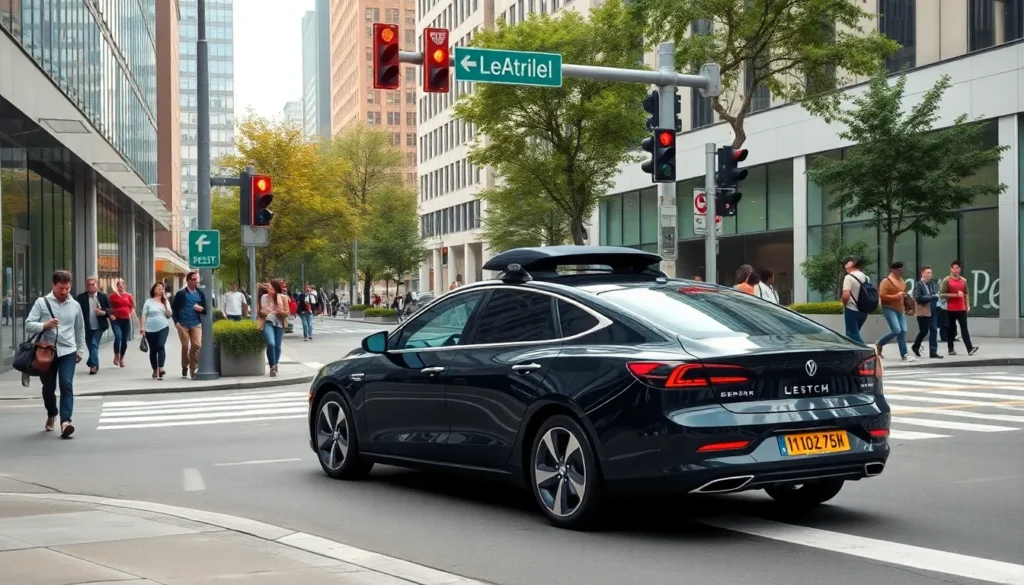Table of Contents
ToggleIn a world where getting from point A to point B often feels like a game of Tetris, emerging technologies in transportation are shaking things up. Imagine a future where traffic jams are nothing but a distant memory and self-driving cars handle the commute while you sip your morning coffee. Sounds dreamy, right? Well, it’s not just a fantasy anymore.
Transportation Research Part C dives into the latest innovations that promise to revolutionize how we travel. From smart traffic management systems to electric vehicles that practically charge themselves, these advancements are not just cool—they’re essential for a sustainable future. Buckle up as we explore the cutting-edge technologies that are reshaping the transportation landscape and making our lives a whole lot easier.
Overview of Transportation Research Part C
Transportation Research Part C focuses on the integration of emerging technologies in the transportation field. This publication examines innovative advancements transforming the industry, aiming to improve efficiency and sustainability.
Purpose and Scope
This journal aims to investigate the implications of new technologies in transportation systems. It covers various aspects, including the impact on traffic management, travel behavior, and infrastructure development. The scope includes interdisciplinary research, engaging with fields such as engineering, computer science, and urban planning. Researchers analyze how technologies like artificial intelligence and big data can enhance operational efficiencies. Through these studies, the journal seeks to inform policymakers and practitioners of strategies that help develop smarter, more sustainable transportation networks.
Key Topics Covered
Key topics explored within this journal include smart transportation systems, autonomous vehicles, and electric mobility. Research articles often highlight the role of IoT in improving traffic flow and reducing congestion. Additionally, studies investigate the use of data analytics to enhance public transport reliability. Researchers also delve into the environmental benefits of emerging technologies, emphasizing their potential to reduce carbon emissions. The integration of user-centric designs in transportation solutions further receives attention, focusing on enhancing the travel experience and safety for all road users.
Emerging Technologies in Transportation

Emerging technologies are swiftly transforming transportation. Innovations help streamline movements and enrich user experiences across various modalities.
Innovations in Autonomous Vehicles
Autonomous vehicles are redefining mobility. Self-driving technology equips vehicles with advanced sensors and software, allowing them to navigate without human intervention. Companies like Waymo and Tesla are at the forefront of these developments, performing extensive testing on public roads. Data indicates that autonomous vehicles could reduce traffic accidents by up to 90% through precise monitoring and quick reaction times. Enhanced safety features also include automatic braking systems and collision avoidance mechanisms. Public acceptance remains crucial, and ongoing trials aim to address safety concerns while demonstrating reliability in daily commuting.
Advancements in Smart Infrastructure
Smart infrastructure complements advancements in autonomous vehicles. Investments in smart traffic signals use real-time data to optimize traffic flow and reduce congestion. These systems adjust signal phases based on current traffic conditions, enhancing commuter efficiency. Additionally, connected roadways support vehicle-to-infrastructure communication, allowing vehicles to receive important alerts about road conditions. Streets equipped with sensor technology monitor vehicle counts and pedestrian activity, facilitating data-driven planning and management. Environmental sustainability factors prominently in infrastructure upgrades, promoting energy-efficient designs and reducing the carbon footprint. Its integration into urban environments achieves more resilient, responsive transport networks.
Impact on Urban Mobility
Emerging technologies significantly influence urban mobility by reshaping how cities design and manage transportation systems. These advancements promote efficient, sustainable travel solutions.
Integrating Technology into City Planning
Integrating technology into city planning enhances overall mobility strategies. Smart infrastructure allows for real-time data collection, which helps urban planners make informed decisions. Participatory approaches engage community members, ensuring that their needs shape development. Cities utilizing geographic information systems (GIS) can visualize traffic patterns effectively. Investments in wireless communication technology strengthen the connection between vehicles and infrastructure. Enhanced connectivity facilitates data-driven approaches for optimizing traffic flow. Planners can also leverage simulation tools to anticipate future transportation needs, aligning them with emerging trends.
Enhancing Public Transportation Systems
Improving public transportation systems relies heavily on integrating emerging technologies. Smart transit applications streamline navigation and provide real-time updates for users. These systems increase ridership by making public transport more convenient and efficient. Automated fare collection systems reduce delays and enhance user experience. Data analytics allow transit authorities to monitor service patterns and identify areas for improvement. Electric vehicles present sustainable alternatives, reducing emissions associated with traditional public transport. Cities adopting mobility-as-a-service models offer users seamless access to various transport options, further enhancing the efficiency of public transit systems.
Challenges and Considerations
Emerging technologies present various challenges and considerations that must be addressed for successful implementation. These issues range from ethical implications to concerns about data privacy and security.
Ethical Implications
Ethical concerns arise when integrating emerging technologies in transportation. Autonomy in vehicles raises questions about responsibility and accountability in the event of accidents. Developers and manufacturers face scrutiny regarding decision-making algorithms that dictate vehicle behavior. Equity in technology access also remains crucial; disparities in availability could widen the gap between different socioeconomic groups. Moreover, public trust in autonomous systems hinges on transparency and ethical integrity, affecting user adoption rates and overall success.
Data Privacy and Security Concerns
Data privacy and security pose significant challenges with the rise of smart transportation systems. Connected vehicles transmit vast amounts of data, potentially exposing personal information to unauthorized access. Ensuring robust encryption methods and secure communication protocols is essential for protecting user data. Regulations, such as the General Data Protection Regulation (GDPR), set critical benchmarks for data handling practices within transportation technologies. Additionally, addressing cybersecurity threats becomes paramount, as vulnerabilities in vehicle networks could lead to serious safety risks and undermine public trust in innovative transportation solutions.
Future Trends in Transportation Research
Emerging technologies are set to reshape transportation, driving innovations and policy changes. Research explores various avenues for improvement and sustainability.
Potential Innovations on the Horizon
Mind-blowing advancements will likely emerge, impacting vehicle design and traffic management. Electric vertical takeoff and landing vehicles promise to revolutionize urban air mobility. Predictive analytics in transportation can optimize traffic flow, reducing congestion substantially. Furthermore, micro-mobility solutions, such as e-scooters and bike shares, present new alternatives for short-distance travel. Smart road systems equipped with sensors allow vehicles to communicate with infrastructure, improving safety and efficiency significantly. Wi-Fi connected buses could enhance passenger experience, offering real-time updates and improved access to amenities.
The Role of Policy in Emerging Technologies
Policies will play a crucial role in regulating and facilitating the deployment of new transportation technologies. Governments must create comprehensive frameworks that ensure safety, accessibility, and environmental standards. Collaboration between public and private sectors can accelerate technology adoption, addressing infrastructure needs effectively. Regulations surrounding data privacy are vital, as users demand security with the rise of connected systems. Additionally, policies that promote equitable access will address disparities in technology utilization. Guidelines for autonomous vehicles will shape public acceptance and ethical standards, guiding manufacturers and users alike.
Emerging technologies are set to revolutionize transportation in ways previously thought impossible. With advancements in autonomous vehicles smart infrastructure and data-driven solutions the future promises safer more efficient and environmentally friendly travel options. As cities adapt to these innovations the focus will remain on enhancing user experience and ensuring equitable access for all.
The ongoing research highlighted in “Transportation Research Part C” will play a pivotal role in shaping policies and practices that govern these technologies. By addressing the challenges and ethical considerations that accompany such rapid advancements stakeholders can work together to build a transportation ecosystem that meets the needs of today while paving the way for a sustainable future.





